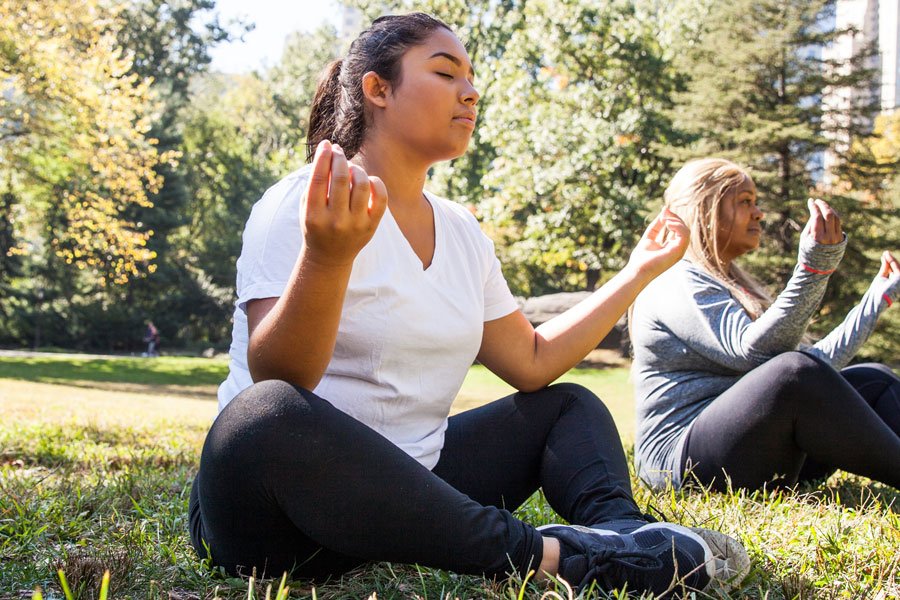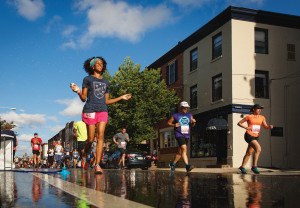Being “Good at Yoga” Doesn’t Mean What You Think It Does
No, it’s not all about handstands.

What does “good at yoga” really mean, anyways? / Photograph by Leo Patrizi/Getty Images.
Jenny Weinar is a Philly-based body positive psychotherapist and certified yoga teacher who’s passionate about helping clients struggling with disordered eating, chronic dieting, over-exercising and weight preoccupation find their way home to their bodies. This is the fifth of a series of posts that will (hopefully!) help our readers do the same. Read Weinar on Be Well every other Tuesday.
From its depiction in the media and on Instagram these days, you might think yoga is all about handstands and contorting oneself into impossible shapes in expensive leggings. And because there’s a well-known and serious lack of representation among these images — lots of thin, white, able-bodied women — it’s easy for anyone who doesn’t fit that limited mold to feel that yoga is off-limits to them.
For this reason, I hear many of my therapy clients, who are working to love themselves and respect their bodies at any size, say that they’re “just not good at yoga.” My heart always drops a little every time, because — while I would never suggest that everyone needs to practice yoga — this very belief often prevents people from trying to build a practice that works for them.
But I’ll let you in on a little secret: there’s really no such thing as being “good at yoga.” Even the designations of beginner, intermediate, and advanced yoga can be problematic. Sure, they help set an expectation for the vigorousness of the class, but I’d argue that the physical demands of yoga practice are not what make it advanced.
In my early years of practicing yoga, I believed that forcing myself into the deepest expression of every pose was the goal. This ultimately led to overstretching in some of my ligaments, a painful outcome that is fairly common amongst overzealous practitioners. When I started my yoga teacher training at Studio 34 in West Philly, known for its inclusive atmosphere, it was a revelation to learn that listening to and respecting my body was perhaps the most advanced form of yoga possible.
Sara Watts, a Philly-based yoga instructor, shared a similar experience with overstretching and injury in her early years of practice. Now she defines the most advanced version of a pose as whichever “best suits the body, mind, and spirit.” Watts guides her classes to turn inward and reflect on what they hope to gain from their practice. She also strongly encourages the use of props, rest, and variations throughout class to help students move into whatever expression of a posture works for their body on that day.
View this post on Instagram
Cohbe Berkeley — co-founder of Vibes and Vinyasa, a Philly-based pop-up yoga program committed to inclusivity — agrees that this ability to adapt your practice to your body is significant. According to Berkeley, “advanced” practitioners will adjust their practice day-to-day, moment-to-moment, based on their body’s unique needs. This might include modifying chaturanga on the knees to ensure proper alignment or using blocks when lunging or twisting. “Advanced” yoga isn’t about how extreme the pose is — it’s about respecting the body’s limitations and maintaining the integrity of the pose.
But ultimately, it’s also not just about the physical practice. “Yoga is meditation, yoga is breathing, yoga is searching and understanding oneself,” says Berekeley, “In today’s society, sitting with yourself, tuning out the world, acknowledging the thoughts of the mind and not getting wrapped up in them, and listening to your breath is advanced yoga.”
Dana Falsetti is a voice in the body-positivity movement who operates a pay-what-you-can, size- and ability-inclusive online studio from her office in Philadelphia. Falsetti also believes that “advanced yoga” has nothing to do with impressive-looking poses and everything to do with self awareness and connecting to yourself and “your mental, emotional, and physical needs as they change.”
“It’s about bringing the foundations of yoga into your life and incorporating them in an intentional way,” says Falsetti. “You don’t have to progress through postures to advance. There is no hierarchy. Your abilities don’t have to change. You advance the more you come home to yourself.”
View this post on Instagram
For these reasons, “advanced” yoga may look different for everyone. Advancing your practice might simply mean cultivating mindfulness throughout your day, trying meditation, or bringing new awareness to your breath. It might mean studying yoga’s cultural roots and incorporating some of its principles, such as non-violence and truthfulness, into your daily life.
If you’re into the physical practice, advanced yoga might be honoring your body’s desire to rest in child’s pose while everyone else continues to flow. Or it may mean using all the blocks and props you need to support your body, allowing for softening rather than straining. Advanced yoga happens when the mind-body connection transcends the ego, and that is a path you can choose today, right now, in the body you’re in at this very moment.


